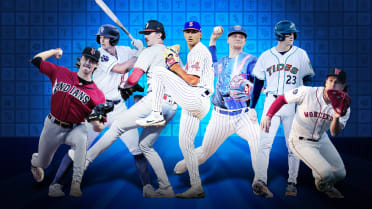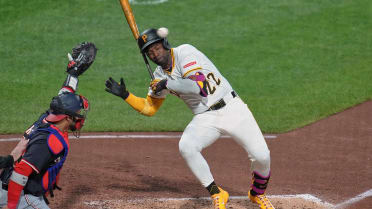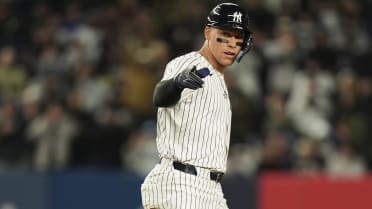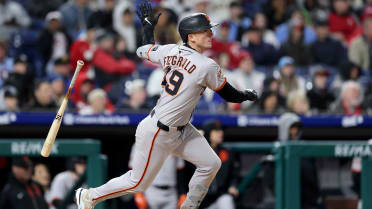It was my first big assignment for The Sporting News in 1998, and I was nervous. It was the All-Star break, and it was my job to set up a meeting between Hall of Famer Bob Gibson and then-Phillies right-hander Curt Schilling -- two of the most feared pitchers in baseball history -- at the Breckenridge Brewery in Denver.
Gibson, who died Friday of pancreatic cancer, was chosen by TSN because it was the 30th anniversary of the Year of the Pitcher. In 1968, Major League hitters had a historically low .237 cumulative average, and Gibson had a season for the ages, winning 22 games with a 1.12 ERA while taking home both the National League MVP and Cy Young Awards.
Schilling, who was an All-Star with the Phillies in 1998, was a few years away from his legendary 2001 and '04 heroics, but he had been a postseason star five years earlier.
The goal was to have Gibson and Schilling talk about the art of pitching and their baseball careers -- and perhaps some things they had in common. Both of their Major League careers got off to slow starts, but they became stars by the time they were in their mid-20s. For both players, it took one person to believe in their skills and help them turn the corner. In Gibson’s case, it was Cardinals manager Johnny Keane. Schilling had Phillies manager Jim Fregosi in his corner.
Gibson’s reputation was well known. His facial expression had come to define “intimidation.” It didn’t matter if he was on the mound or in street clothes. Schilling at that time wasn’t the polarizing voice that he is today, and had then -- as he does now -- an appreciation for baseball history.
When Gibson and Schilling met, it was like they knew each other for years. Schilling acted like a little kid, pulling out his All-Star Glove for Gibson to sign. Gibson obliged. They spoke the mutual language of pitching, intensity and being fearless on the mound. Schilling declared that nobody again will have a dream season like Gibson had in 1968.
“Number 1, nobody will throw 300 innings again, because they don’t get enough appearances,” Schilling said. “Nobody will throw 28 complete games in a season. I will struggle to get to 14. Pedro Martinez won the Cy Young [in 1997] and everybody marveled at a 1.90 ERA. But nobody is ever coming close to 1.12 ERA.”
Gibson, in turn, credited his control for having his ridiculous season.
“I really didn’t have to think about where I wanted to throw the ball. All I did was throw it there,” Gibson said. “There are a lot of instances where you think, think, think and you try to get the ball where you want to throw it and you don’t get it there. That year, it seems that all I had to do was throw it and it got there.”
Both Gibson and Schilling had agreed on a lot of things when it came to the art of pitching, and it comes as no surprise that both lamented the impact umpires could make on any particular night.
“Each umpire has a different strike zone. They call the game a little differently,” Gibson said. “There’s not going to be any consistency on the strike zone or how a game is called. Whatever the umpire does has a great bearing on the outcome of a game. Period.”
At the time of the interview, Gibson had been retired from baseball for 23 years and he wasn’t afraid to express his bitterness towards Solly Hemus, his first big league manager. Under Hemus, Gibson was in and out of the big leagues, and one could tell Gibson had hard feelings about his former manager.
“I won’t even mention this guy’s name, but he didn’t have any confidence in me,” Gibson said. “So, I just didn’t have confidence in myself. And I think the worst thing in the world is being a young person and knowing the manager doesn’t have the confidence in you. So now, you lose a lot of confidence in yourself.”
Hemus was relieved of his duties and replaced by Keane in 1961. Gibson’s career took a turn for the better and he ended up as a Hall of Famer, winning 251 games with an ERA of 2.91 and Cy Young Awards in ’68 and ’70.
Gibson had a reputation of throwing inside ferociously, but he said then -- and maintained throughout his life -- that he didn’t actually hit that many batters. And he was right: Gibson hit 102 batters in his 17-year career. That’s only six batters per season.
“They think when you throw inside, you are trying to intimidate somebody, you are trying to knock them down, you are trying to hit them. It’s none of the above,” Gibson said. “You pitch inside to make them think inside. If you continually pitch inside, you are not going to get anybody out. … I don’t care what year you pitched, to consistently get somebody out, it has to be out there [outside part of the plate]. But you have to keep him from going out there. When you pitch inside, it’s not to hit anybody or scare anybody.”
After two hours of talking baseball and eating dinner, Gibson and Schilling said goodbye and went their separate ways. I remember I walked Gibson back to his hotel. Suddenly, he had an asthma attack. At that moment, I thought about his commercials for Primatene Mist, which is used to treat asthma attacks. I wanted to walk him to his room, but he insisted he was going to be OK.
“Are you sure?” I asked.
Gibson waved me away and said goodbye. It turned out he was all right. At that moment, I thought, "This is truly a tough guy."
Bill Ladson has been a reporter for MLB.com since 2002. He covered the Nationals/Expos from 2002-2016.




